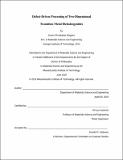| dc.contributor.advisor | Silvija Gradečak. | en_US |
| dc.contributor.author | Bogaert, Kevin Christopher. | en_US |
| dc.contributor.other | Massachusetts Institute of Technology. Department of Materials Science and Engineering. | en_US |
| dc.date.accessioned | 2019-09-16T16:42:14Z | |
| dc.date.available | 2019-09-16T16:42:14Z | |
| dc.date.copyright | 2019 | en_US |
| dc.date.issued | 2019 | en_US |
| dc.identifier.uri | https://hdl.handle.net/1721.1/122072 | |
| dc.description | This electronic version was submitted by the student author. The certified thesis is available in the Institute Archives and Special Collections. | en_US |
| dc.description | Thesis: Ph. D., Massachusetts Institute of Technology, Department of Materials Science and Engineering, 2019 | en_US |
| dc.description | Cataloged from student-submitted PDF version of thesis. | en_US |
| dc.description | Includes bibliographical references (pages 149-161). | en_US |
| dc.description.abstract | Two-dimensional transition metal dichalcogenides (TMDs) are an emerging class of semiconductor materials that offer exciting new properties for future electronic and optoelectronic applications. However, many ongoing challenges related to synthesis and processing must be overcome before this nascent technology can become industrially viable. In this thesis, processing-related phenomena relevant to the fabrication of TMD heterostructures, alloys, and nanoporous membranes are presented. This thesis begins with an investigation of the role of substrate temperature in two-step chemical vapor deposition (CVD) growth of MoS₂/WS₂ heterostructures. We demonstrate diffusion-mediated synthesis of inverted lateral heterostructures following low MoS2 growth temperatures in the second CVD step and homogeneous Mo[subscript x]W[subscript 1-x]S₂ alloyed crystals following higher MoS₂ growth temperatures. | en_US |
| dc.description.abstract | Investigating the nature of this diffusion-mediated process, we identify an energetically favorable atomistic model proposing that transition metal diffusion is driven by a heterogeneous distribution of sulfur vacancies. This model is corroborated by the synthesis of a composition-graded Mo[subscript x]W[subscript 1-x]S₂ alloy crystals in which the final-stage spatial distribution of transition metal atoms correlates with intermediate-stage distribution of point defects. These heterogeneous crystals allow for correlation of the local optical properties with the local composition, demonstrating a variation in photoluminescence intensity spanning two orders of magnitude and reaching the maximum value for equicompositional alloy Mo₀.₅W₀.₅S₂ (x=0.5). Furthermore, the correlation between intermediate-stage distribution of point defects and final-stage spatial distribution of transition metal atoms enables the opportunity for bespoke patterning. | en_US |
| dc.description.abstract | Utilizing a laser annealing technique, we demonstrate the ability to locally induce defects that define the regions of preferential nucleation during subsequent CVD growth. Finally, defect processing is also demonstrated in nanoporous TMD membrane applications. Combining modeling with experimentation, we demonstrate the relationship between vacuum annealing time and temperature with nanopore properties such as average radius and edge structure. Control of these properties is essential for the fabrication of functional nanoporous membrane devices for sensing, filtration, and energy applications. This thesis motivates further work on TMD processing in pursuit of developing a fundamental understanding of the defect-driven diffusion mechanism, a larger library of interesting TMD compositions and structures, as well as industrially viable TMD devices. | en_US |
| dc.description.statementofresponsibility | by Kevin Christopher Bogaert. | en_US |
| dc.format.extent | 161 pages | en_US |
| dc.language.iso | eng | en_US |
| dc.publisher | Massachusetts Institute of Technology | en_US |
| dc.rights | MIT theses are protected by copyright. They may be viewed, downloaded, or printed from this source but further reproduction or distribution in any format is prohibited without written permission. | en_US |
| dc.rights.uri | http://dspace.mit.edu/handle/1721.1/7582 | en_US |
| dc.subject | Materials Science and Engineering. | en_US |
| dc.title | Defect-driven processing of two-dimensional transition metal dichalcogenides | en_US |
| dc.type | Thesis | en_US |
| dc.description.degree | Ph. D. | en_US |
| dc.contributor.department | Massachusetts Institute of Technology. Department of Materials Science and Engineering | en_US |
| dc.identifier.oclc | 1117714987 | en_US |
| dc.description.collection | Ph.D. Massachusetts Institute of Technology, Department of Materials Science and Engineering | en_US |
| dspace.imported | 2019-09-16T16:42:11Z | en_US |
| mit.thesis.degree | Doctoral | en_US |
| mit.thesis.department | MatSci | en_US |
